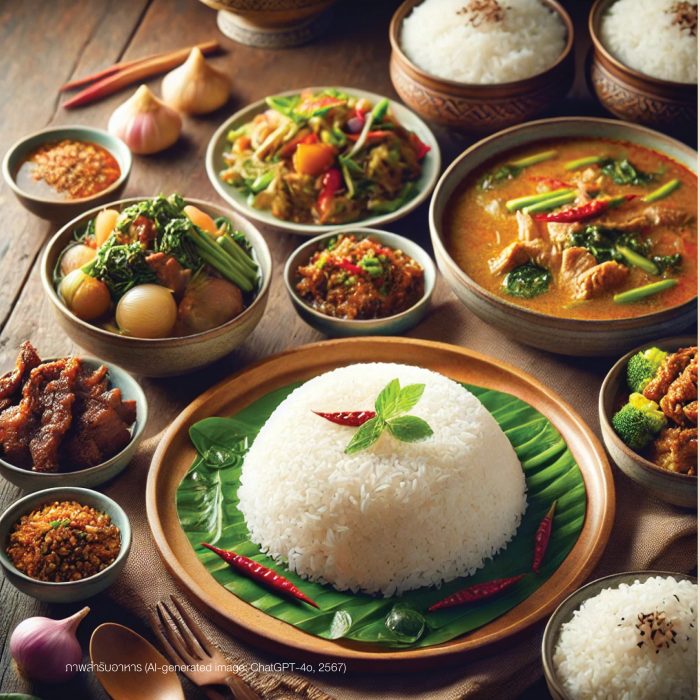
What is the food set?
Traditionally, food in a household is organized into a food set, consisting of rice and various side dishes. When a food set is prepared, each person typically receives only rice on their plate, while the other dishes are meant to be shared by the group. In essence, a food set is composed of rice and accompanying “side dishes,” often with a sweet dish or fruit served at the end. The ancients categorized these side dishes into groups, referring to each type as a “khrueng,” a term that will be further explained in the context of food set organization.
The food set organization
The organization of a traditional food set centers around rice as the main component. Side dishes are carefully chosen and prepared to complement the sensory characteristics of the rice, such as its color, aroma, taste, and texture. Additionally, the selection and arrangement of these dishes are tailored to suit the preferences, genders, and ages of the diners, while also taking into account factors like the season, time of day, and the expected duration of the meal.
For instance, when sticky rice is served, the side dishes are specifically chosen to complement the way sticky rice is traditionally eaten, by forming the rice into small balls with your hands and dipping it. The side dishes should enhance the flavor and texture of the rice and be convenient for hand-to-mouth eating. As a result, dishes that are paired well with sticky rice are often dipping sauces or bite-sized pieces of food. Because of its natural “sticky” texture, sticky rice is traditionally eaten with the hands, making it impractical to use a fork and spoon. Therefore, curry dishes are not well-suited with sticky rice. In contrast, cooked rice has a looser texture and does not clump together like sticky rice, making it ideal for eating with a fork and spoon. The use of utensils allows for other varieties, including soups, curries, and other liquid-based dishes, to be added to the meal.
Historical data suggests that this region of the country was once dominated by sticky rice cultivation. Scholars, including Sujit Wongthes, argued that over two thousand years ago, the population consumed sticky rice, as regular white rice was not yet available. Archaeological evidence from ancient sites supports this, revealing rice grains found near human skeletons and in ancient pots and jars. Based on this information, Dr. Nippatchanok utilized food science to interpret the data, suggesting that sticky rice influenced early human dietary choices and the selection of side dishes long before the consumption of white rice.
Dipping sauces, characterized by their semi-solid and semi-liquid nature, may provide insight into the vast diversity within this food type and the limitless potential for their development. Variations such as different types of Nam Phrik; despite sharing the same name, Nam Phrik differs across households and regions, along with others such as Lon (a thick curry), Sang wa (herb and vegetable paste), Nam Chup (southern shrimp paste), Jaew or Pon (chili pastes), and a wide array of other dipping sauces.
Sujit Wongthes further explained that the introduction of long-grained rice from the Indians gradually influenced the local population over time. Approximately a thousand years ago, the crossbreeding between primitive sticky rice and hard-grained rice resulted in the modern rice variety known as Khao Suay or Khao Chao (white rice). This loose rice is eaten by a spoon, which eventually became a main dish throughout the country and this continental region. The new and vibrant dishes were accordingly created to enrich both nourishment and pleasure.
Dr. Nippatchanok conducted a study of several historical cookbooks and identified Mae Krua Hua Pa, authored by Lady Plian Phasakonwong, as the most comprehensive in explaining the organization, components, and functions of traditional food sets. The data was analyzed in conjunction with the patterns of rice consumption and accompanying side dishes as previously described. Through an anthropological and sociology lens, this analysis suggests that communal food sharing among agricultural groups serves as a significant social activity by allowing individuals to share both happiness and hardship in their lives. As Thai household activities are intertwined with agriculture, lifestyles, and economics, the interpretation of data requires the use of a diverse range of analytical tools
